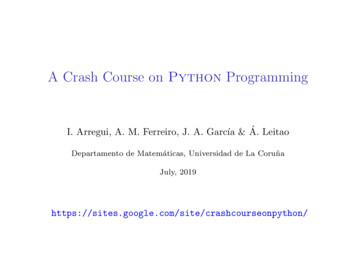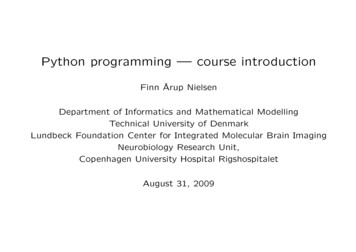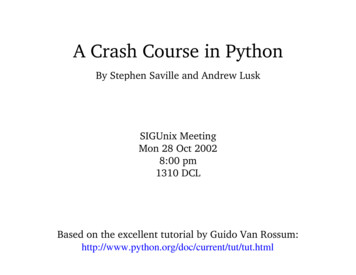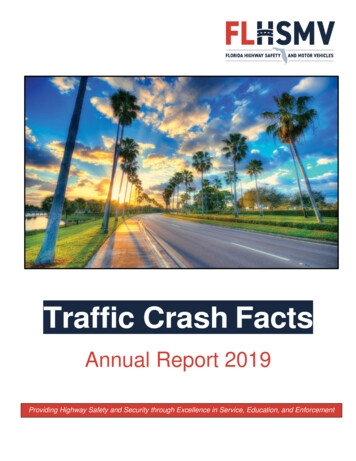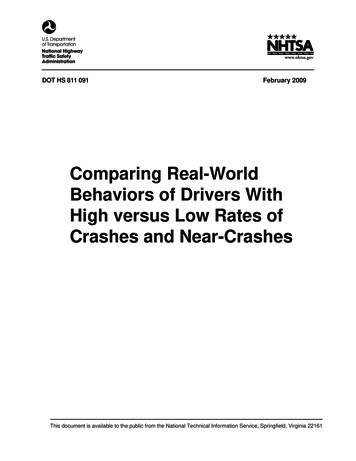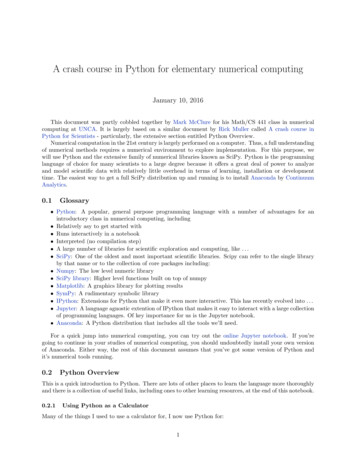
Transcription
A crash course in Python for elementary numerical computingJanuary 10, 2016This document was partly cobbled together by Mark McClure for his Math/CS 441 class in numericalcomputing at UNCA. It is largely based on a similar document by Rick Muller called A crash course inPython for Scientists - particularly, the extensive section entitled Python Overview.Numerical computation in the 21st century is largely performed on a computer. Thus, a full understandingof numerical methods requires a numerical environment to explore implementation. For this purpose, wewill use Python and the extensive family of numerical libraries known as SciPy. Python is the programminglanguage of choice for many scientists to a large degree because it offers a great deal of power to analyzeand model scientific data with relatively little overhead in terms of learning, installation or developmenttime. The easiest way to get a full SciPy distribution up and running is to install Anaconda by ContinuumAnalytics.0.1Glossary Python: A popular, general purpose programming language with a number of advantages for anintroductory class in numerical computing, including Relatively asy to get started with Runs interactively in a notebook Interpreted (no compilation step) A large number of libraries for scientific exploration and computing, like . . . SciPy: One of the oldest and most important scientific libraries. Scipy can refer to the single libraryby that name or to the collection of core packages including: Numpy: The low level numeric library SciPy library: Higher level functions built on top of numpy Matplotlib: A graphics library for plotting results SymPy: A rudimentary symbolic library IPython: Extensions for Python that make it even more interactive. This has recently evolved into . . . Jupyter: A language agnostic extention of IPython that makes it easy to interact with a large collectionof programming languages. Of key importance for us is the Jupyter notebook. Anaconda: A Python distribution that includes all the tools we’ll need.For a quick jump into numerical computing, you can try out the online Jupyter notebook. If you’regoing to continue in your studies of numerical computing, you should undoubtedly install your own versionof Anaconda. Either way, the rest of this document assumes that you’ve got some version of Python andit’s numerical tools running.0.2Python OverviewThis is a quick introduction to Python. There are lots of other places to learn the language more thoroughlyand there is a collection of useful links, including ones to other learning resources, at the end of this notebook.0.2.1Using Python as a CalculatorMany of the things I used to use a calculator for, I now use Python for:1
In [1]: 2 2Out[1]: 4In [2]: (50-5*6)/4Out[2]: 5.0(If you’re typing this into an IPython notebook, or otherwise using notebook file, you hit shift-Enter toevaluate a cell.)You can define variables using the equals ( ) sign:In [3]: width 20length 30area length*widthareaOut[3]: 600If you try to access a variable that you haven’t yet defined, you get an error:In [4]: ------------------------------NameErrorTraceback (most recent call last) ipython-input-4-0c7fc58f9268 in module ()---- 1 volumeNameError: name ’volume’ is not definedand you need to define it:In [5]: depth 10volume area*depthvolumeOut[5]: 6000You can name a variable almost anything you want. It needs to start with an alphabetical character or“ ”, can contain alphanumeric charcters plus underscores (“ ”). Certain words, however, are reserved for thelanguage:and, as, assert, break, class, continue, def, del, elif, else, except,exec, finally, for, from, global, if, import, in, is, lambda, not, or,pass, print, raise, return, try, while, with, yieldTrying to define a variable using one of these will result in a syntax error:In [6]: return 02
File " ipython-input-6-2b99136d4ec6 ", line 1return 0 SyntaxError: invalid syntaxNow, let’s take a look at an import statement. Python has a huge number of libraries included with thedistribution. To keep things simple, most of these variables and functions are not accessible from a normalPython interactive session. Instead, you have to import the name. For example, there is a math modulecontaining many useful functions. To access, say, the square root function, you can either firstIn [7]: from math import sqrtand thenIn [8]: sqrt(81)Out[8]: 9.0or you can simply import the math library itselfIn [9]: import mathmath.sqrt(81)Out[9]: 9.0Note, however, that a numerical analyst will often prefer to use the math functionality available in numpy.0.2.2Data typesNumbers Python is dynamically typed, but it is still typed. In particular, there are three disctinct kindsof numbers int, float, and complex.An int can have unlimited precision.In [10]: 2**(1001)-1Out[10]: 672148875007767407021022498722449863967576313A complex has a real and imaginary part and is easily entered in the form a bj.In [11]: (2 3j)**3Out[11]: (-46 9j)We are mostly interested in floats which can be used to model real numbers and are typically implemented internally as C doubles. Note that there is a distinction between a float and an int.In [12]: 1 is 1.0Out[12]: False3
StringsStrings are lists of printable characters, and can be defined using either single quotesIn [13]: ’Hello, World!’Out[13]: ’Hello, World!’or double quotesIn [14]: "Hello, World!"Out[14]: ’Hello, World!’But not both at the same time, unless you want one of the symbols to be part of the string.In [15]: "He’s a Rebel"Out[15]: "He’s a Rebel"In [16]: ’She asked, "How are you today?"’Out[16]: ’She asked, "How are you today?"’Just like the other two data objects we’re familiar with (ints and floats), you can assign a string to avariableIn [17]: greeting "Hello, World!"The print statement is often used for printing character strings:In [18]: print(greeting)Hello, World!But it can also print data types other than strings:In [19]: print("The area is ",area)The area is600In the above snipped, the number 600 (stored in the variable “area”) is converted into a string beforebeing printed out.You can use the operator to concatenate strings together:In [20]: statement "Hello," "World!"print(statement)Hello,World!Don’t forget the space between the strings, if you want one there.In [21]: statement "Hello, " "World!"print(statement)Hello, World!You can use to concatenate multiple strings in a single statement:In [22]: print("This " "is " "a " "longer " "statement.")This is a longer statement.If you have a lot of words to concatenate together, there are other, more efficient ways to do this. Butthis is fine for linking a few strings together.4
Lists Very often in a programming language, one wants to keep a group of similar items together. Pythondoes this using a data type called lists.In [23]: days of the week ","Friday","Saturday"]You can access members of the list using the index of that item:In [24]: days of the week[2]Out[24]: ’Tuesday’Python lists, like C, but unlike Fortran, use 0 as the index of the first element of a list. Thus, in thisexample, the 0 element is “Sunday”, 1 is “Monday”, and so on. If you need to access the nth element fromthe end of the list, you can use a negative index. For example, the -1 element of a list is the last element:In [25]: days of the week[-1]Out[25]: ’Saturday’You can add additional items to the list using the .append() command:In [26]: languages ["Fortran","C","C rtran’, ’C’, ’C ’, ’Python’]The range() command is a convenient way to make sequential lists of numbers:In [27]: list(range(10))Out[27]: [0, 1, 2, 3, 4, 5, 6, 7, 8, 9]Note that range(n) starts at 0 and gives the sequential list of integers less than n. If you want to startat a different number, use range(start,stop)In [28]: list(range(2,8))Out[28]: [2, 3, 4, 5, 6, 7]The lists created above with range have a step of 1 between elements. You can also give a fixed step sizevia a third command:In [29]: evens list(range(0,20,2))evensOut[29]: [0, 2, 4, 6, 8, 10, 12, 14, 16, 18]In [30]: evens[3]Out[30]: 6Lists do not have to hold the same data type. For example,In [31]: ["Today",7,99.3,""]Out[31]: [’Today’, 7, 99.3, ’’]5
However, it’s good (but not essential) to use lists for similar objects that are somehow logically connected.If you want to group different data types together into a composite data object, it’s best to use tuples, whichwe will learn about below.You can find out how long a list is using the len() command:In [32]: help(len)Help on built-in function len in module builtins:len(obj, /)Return the number of items in a container.In [33]: len(evens)Out[33]: 100.2.3Iteration, Indentation, and BlocksOne of the most useful things you can do with lists is to iterate through them, i.e. to go through each elementone at a time. To do this in Python, we use the for statement:In [34]: for day in days of the yFridaySaturdayThis code snippet goes through each element of the list called days of the week and assigns it to thevariable day. It then executes everything in the indented block (in this case only one line of code, the printstatement) using those variable assignments. When the program has gone through every element of the list,it exists the block.(Almost) every programming language defines blocks of code in some way. In Fortran, one uses ENDstatements (ENDDO, ENDIF, etc.) to define code blocks. In C, C , and Perl, one uses curly braces {} todefine these blocks.Python uses a colon (“:”), followed by indentation level to define code blocks. Everything at a higherlevel of indentation is taken to be in the same block. In the above example the block was only a single line,but we could have had longer blocks as well:In [35]: for day in days of the week:statement "Today is " sdayFridaySaturdayThe range command is particularly useful with the for statement to execute loops of a specified length.Note that if we enter just a range we get, well, a range.6
In [36]: range(20)Out[36]: range(0, 20)This is why we wrapped the previous range’s in list. While this might seem odd, the point is that itis an iterable.In [37]: for i in range(20):print("The square of ",i," is cingLists and strings have something in common that you might not suspect: they can both be treated assequences. You already know that you can iterate through the elements of a list. You can also iteratethrough the letters in a string:In [38]: for letter in "Sunday":print(letter)SundayThis is only occasionally useful. Slightly more useful is the slicing operation, which you can also use onany sequence. We already know that we can use indexing to get the first element of a list:In [39]: days of the week[0]Out[39]: ’Sunday’If we want the list containing the first two elements of a list, we can do this viaIn [40]: days of the week[0:2]7
Out[40]: [’Sunday’, ’Monday’]or simplyIn [41]: days of the week[:2]Out[41]: [’Sunday’, ’Monday’]If we want the last items of the list, we can do this with negative slicing:In [42]: days of the week[-2:]Out[42]: [’Friday’, ’Saturday’]which is somewhat logically consistent with negative indices accessing the last elements of the list.You can do:In [43]: workdays days of the week[1:6]print(workdays)[’Monday’, ’Tuesday’, ’Wednesday’, ’Thursday’, ’Friday’]Since strings are sequences, you can also do this to them:In [44]: day "Sunday"abbreviation day[:3]print(abbreviation)SunIf we really want to get fancy, we can pass a third element into the slice, which specifies a step length(just like a third argument to the range() function specifies the step):In [45]: numbers range(0,40)evens numbers[2::2]list(evens)Out[45]: [2, 4, 6, 8, 10, 12, 14, 16, 18, 20, 22, 24, 26, 28, 30, 32, 34, 36, 38]Note that in this example I was even able to omit the second argument, so that the slice started at 2,went to the end of the list, and took every second element, to generate the list of even numbers less that 40.0.2.5Booleans and Truth TestingWe have now learned a few data types. We have integers and floating point numbers, strings, and lists tocontain them. We have also learned about lists, a container that can hold any data type. We have learnedto print things out, and to iterate over items in lists. We will now learn about boolean variables that canbe either True or False.We invariably need some concept of conditions in programming to control branching behavior, to allowa program to react differently to different situations. If it’s Monday, I’ll go to work, but if it’s Sunday, I’llsleep in. To do this in Python, we use a combination of boolean variables, which evaluate to either Trueor False, and if statements, that control branching based on boolean values.For example:In [46]: if day "Sunday":print("Sleep in")else:print("Go to work")8
Sleep in(Quick quiz: why did the snippet print “Go to work” here? What is the variable “day” set to?)Let’s take the snippet apart to see what happened. First, note the statementIn [47]: day "Sunday"Out[47]: TrueIf we evaluate it by itself, as we just did, we see that it returns a boolean value, False. The “ ” operatorperforms equality testing. If the two items are equal, it returns True, otherwise it returns False. In this case,it is comparing two variables, the string “Sunday”, and whatever is stored in the variable “day”, which, inthis case, is the other string “Saturday”. Since the two strings are not equal to each other, the truth testhas the false value.The if statement that contains the truth test is followed by a code block (a colon followed by an indentedblock of code). If the boolean is true, it executes the code in that block. Since it is false in the aboveexample, we don’t see that code executed.The first block of code is followed by an else statement, which is executed if nothing else in the above ifstatement is true. Since the value was false, this code is executed, which is why we see “Go to work”.You can compare any data types in Python:In [48]: 1 2Out[48]: FalseIn [49]: 50 2*25Out[49]: TrueIn [50]: 3 3.14159Out[50]: TrueIn [51]: 1 1.0Out[51]: TrueIn [52]: 1 ! 0Out[52]: TrueIn [53]: 1 2Out[53]: TrueIn [54]: 1 1Out[54]: TrueWe see a few other boolean operators here, all of which which should be self-explanatory. Less than,equality, non-equality, and so on.Particularly interesting is the 1 1.0 test, which is true, since even though the two objects are differentdata types (integer and floating point number), they have the same value. There is another boolean operatoris, that tests whether two objects are the same object:In [55]: 1 is 1.0Out[55]: False9
We can do boolean tests on lists as well:In [56]: [1,2,3] [1,2,4]Out[56]: FalseIn [57]: [1,2,3] [1,2,4]Out[57]: TrueFinally, note that you can also string multiple comparisons together, which can result in very intuitivetests:In [58]: hours 50 hours 24Out[58]: TrueIf statements can have elif parts (“else if”), in addition to if/else parts. For example:In [59]: if day "Sunday":print("Sleep in")elif day "Saturday":print("Do chores")else:print("Go to work")Sleep inOf course we can combine if statements with for loops, to make a snippet that is almost interesting:In [60]: for day in days of the week:statement "Today is " dayprint(statement)if day "Sunday":print("Sleep in")elif day "Saturday":print("Do chores")else:print("Go to work")Today is SundaySleep inToday is MondayGo to workToday is TuesdayGo to workToday is WednesdayGo to workToday is ThursdayGo to workToday is FridayGo to workToday is SaturdayDo chores10
This is something of an advanced topic, but ordinary data types have boolean values associated withthem, and, indeed, in early versions of Python there was not a separate boolean object. Essentially, anythingthat was a 0 value (the integer or floating point 0, an empty string “”, or an empty list []) was False, andeverything else was true. You can see the boolean value of any data object using the bool() function.In [61]: bool(1)Out[61]: TrueIn [62]: bool(0)Out[62]: FalseIn [63]: bool(["This "," is "," a "," list"])Out[63]: True1Defining functionsA function is a block of reusable code that is used to perform a single task, typically repeatedly. Theeasiest functions, from the numerical perspective, simply define a mathematical function. For example,f (x) x2 x 1 can be written (using the def operator) and used as follows:In [64]: def f(x): return x**2 - x - 1f(3)Out[64]: 5Note the ** to represent exponentiation! Let’s examine a deeper example involving the Fibonacci sequence. This the sequence (Fn ) defined by F0 0, F1 1, and Fn 1 Fn Fn 1 . In words, it’s the sequencethat starts with 0 and 1, and then each successive entry is the sum of the previous two. Thus, the sequencegoes 0,1,1,2,3,5,8,13,21,34,55,89,. . .A very common exercise in programming books is to compute the Fibonacci sequence up to some numbern. First I’ll show the code, then I’ll discuss what it is doing.In [65]: n 10sequence [0,1]for i in range(2,n): # This is going to be a problem if we ever set n 2!sequence.append(sequence[i-1] sequence[i-2])print(sequence)[0, 1, 1, 2, 3, 5, 8, 13, 21, 34]Let’s go through this line by line. First, we define the variable n, and set it to the integer 20. n isthe length of the sequence we’re going to form, and should probably have a better variable name. We thencreate a variable called sequence, and initialize it to the list with the integers 0 and 1 in it, the first twoelements of the Fibonacci sequence. We have to create these elements “by hand”, since the iterative part ofthe sequence requires two previous elements.We then have a for loop over the list of integers from 2 (the next element of the list) to n (the lengthof the sequence). After the colon, we see a hash tag “#”, and then a comment that if we had set n tosome number less than 2 we would have a problem. Comments in Python start with #, and are good waysto make notes to yourself or to a user of your code explaining why you did what you did. Better than thecomment here would be to test to make sure the value of n is valid, and to complain if it isn’t; we’ll try thislater.In the body of the loop, we append to the list an integer equal to the sum of the two previous elementsof the list.11
After exiting the loop (ending the indentation) we then print out the whole list. That’s it!We might want to use the Fibonacci snippet with different sequence lengths. We could cut an paste thecode into another cell, changing the value of n, but it’s easier and more useful to make a function out of thecode. We do this with the def statement in Python:In [66]: def fibonacci(sequence length):"Return the Fibonacci sequence of length *sequence length*"sequence [0,1]if sequence length 1:print("Fibonacci sequence only defined for length 1 or greater")returnif 0 sequence length 3:return sequence[:sequence length]for i in range(2,sequence length):sequence.append(sequence[i-1] sequence[i-2])return sequenceWe can now call fibonacci() for different sequence lengths:In [67]: fibonacci(2)Out[67]: [0, 1]In [68]: fibonacci(12)Out[68]: [0, 1, 1, 2, 3, 5, 8, 13, 21, 34, 55, 89]We’ve introduced a several new features here. First, note that the function itself is defined as a codeblock (a colon followed by an indented block). This is the standard way that Python delimits things. Next,note that the first line of the function is a single string. This is called a docstring, and is a special kind ofcomment that is often available to people using the function through the python command line:In [69]: help(fibonacci)Help on function fibonacci in modulemain :fibonacci(sequence length)Return the Fibonacci sequence of length *sequence length*If you define a docstring for all of your functions, it makes it easier for other people to use them, sincethey can get help on the arguments and return values of the function.Next, note that rather than putting a comment in about what input values lead to errors, we have sometesting of these values, followed by a warning if the value is invalid, and some conditional code to handlespecial cases.1.1Recursion and FactorialsFunctions can also call themselves, something that is often called recursion. We’re going to experiment withrecursion by computing the factorial function. The factorial is defined for a positive integer n asn! n(n 1)(n 2) · · · 1First, note that we don’t need to write a function at all, since this is a function built into the standardmath library. Let’s use the help function to find out about it:In [70]: from math import factorialhelp(factorial)12
Help on built-in function factorial in module math:factorial(.)factorial(x) - IntegralFind x!. Raise a ValueError if x is negative or non-integral.This is clearly what we want.In [71]: factorial(20)Out[71]: 2432902008176640000However, if we did want to write a function ourselves, we could do recursively by noting thatn! n(n 1)!The program then looks something like:In [72]: def fact(n):if n 0:return 1return n*fact(n-1)In [73]: fact(20)Out[73]: 2432902008176640000Recursion can be very elegant, and can lead to very simple programs.1.2Two More Data Structures: Tuples and DictionariesBefore we end the Python overview, I wanted to touch on two more data structures that are very useful (andthus very common) in Python programs.A tuple is a sequence object like a list or a string. It’s constructed by grouping a sequence of objectstogether with commas, either without brackets, or with parentheses:In [74]: t (1,2,’hi’,9.0)tOut[74]: (1, 2, ’hi’, 9.0)Tuples are like lists, in that you can access the elements using indices:In [75]: t[1]Out[75]: 2However, tuples are immutable, you can’t append to them or change the elements of them:In [76]: raceback (most recent call last) ipython-input-76-50c7062b1d5f in module ()---- 1 t.append(7)AttributeError: ’tuple’ object has no attribute ’append’13
In [77]: t[1] --------------------------TypeErrorTraceback (most recent call last) ipython-input-77-03cc8ba9c07d in module ()---- 1 t[1] 77TypeError: ’tuple’ object does not support item assignmentTuples are useful anytime you want to group different pieces of data together in an object, but don’t wantto create a full-fledged class (see below) for them. For example, let’s say you want the Cartesian coordinatesof some objects in your program. Tuples are a good way to do this:In [78]: (’Bob’,0.0,21.0)Out[78]: (’Bob’, 0.0, 21.0)Again, it’s not a necessary distinction, but one way to distinguish tuples and lists is that tuples are acollection of different things, here a name, and x and y coordinates, whereas a list is a collection of similarthings, like if we wanted a list of those coordinates:In [79]: positions ’,33.0,1.2)]Tuples can be used when functions return more than one value. Say we wanted to compute the smallestx- and y-coordinates of the above list of objects. We could write:In [80]: def minmax(objects):minx 1e20 # These are set to really big numbersminy 1e20for obj in objects:name,x,y objif x minx:minx xif y miny:miny yreturn minx,minyx,y minmax(positions)print(x,y)0.0 1.2Here we did two things with tuples you haven’t seen before. First, we unpacked an object into a set ofnamed variables using tuple assignment: name,x,y obj14
We also returned multiple values (minx,miny), which were then assigned to two other variables (x,y),again by tuple assignment. This makes what would have been complicated code in C rather simple.Tuple assignment is also a convenient way to swap variables:In [81]: x,y 1,2y,x x,yx,yOut[81]: (2, 1)Dictionaries are an object called “mappings” or “associative arrays” in other languages. Whereas a listassociates an integer index with a set of objects:In [82]: mylist [1,2,9,21]The index in a dictionary is called the key, and the corresponding dictionary entry is the value. Adictionary can use (almost) anything as the key. Whereas lists are formed with square brackets [], dictionariesuse curly brackets {}:In [83]: ages {"Rick": 46, "Bob": 86, "Fred": 21}print("Rick’s age is ",ages["Rick"])Rick’s age is46There’s also a convenient way to create dictionaries without having to quote the keys.In [84]: dict(Rick 46,Bob 86,Fred 20)Out[84]: {’Bob’: 86, ’Fred’: 20, ’Rick’: 46}The len() command works on both tuples and dictionaries:In [85]: len(t)Out[85]: 4In [86]: len(ages)Out[86]: 32Important libraries for numerical analysisIn addition to being an excellent and easy to use general purpose language, there are a large number oflibraries that make Python an excellent tool for numerical computing. In this section, we exlore a few ofthese. Note that this is a very brief intro since we will be learning more and more about these packagesthroughout the text.2.1Numpy and ScipyNumpy and Scipy are absolutely central for numerical computing with Python. Numpy is the lower levelof the two and contains core routines for doing fast vector, matrix, and linear algebra-type operations inPython. SciPy, built on top of NumPy, is higher level and contains additional routines for optimization,special functions, and so on. Both contain modules written in C and Fortran so that they’re as fast aspossible. Together, they give Python roughly the same capability that the Matlab program offers. (In fact,if you’re an experienced Matlab user, there a guide to Numpy for Matlab users just for you.)There are several ways to import NumPy:15
In [87]: # Import all of NumPy into the global namespacefrom numpy import *In [88]: # Import NumPy into it’s own namespaceimport numpyIn [89]: # Import NumPy into a namespace with a shorter nameimport numpy as npThe first version is particularly convenient for interactive work but frowned upon for serious programming.We will often use the third version. Among other things, this provides some trig and related tools. Here’show to compute the cosine of π:In [90]: np.cos(np.pi)Out[90]: -1.0SciPy provides higher level functionality largely broken into submodules. If we want to integrate afunction numerically, for example, we can use the quad function provided in the scipy.integrate module.In [91]: from scipy.integrate import quadquad(np.sin, 0, np.pi)Out[91]: (2.0, 2.220446049250313e-14)This says that the value of the integral is 2.0 to an accuracy of about 2.22 10 14 . We’ll talk much moreabout this later!NumPy and SciPy fundamentally work very well with arrays. These might represent vectors, matrices,or some other structured data. When they do represent vectors or matrices, SciPy has natural built in toolsfor linear algebra. In numerical analysis, we are often interested in studying the behavior of functions overan interval by sampling the function over an interval; the linspace command is useful in this context. Forexample, the following generates 101 points evenly distributed throughout the interval [ 2, 2].In [92]: np.linspace(-2,2,101)Out[92]: array([-2. ,-1.64,-1.28,-0.92,-0.56,-0.2 ,0.16,0.52,0.88,1.24,1.6 ,1.96,2.2-1.96, -1.92,-1.6 , -1.56,-1.24, -1.2 ,-0.88, -0.84,-0.52, -0.48,-0.16, -0.12,0.2 , 0.24,0.56, 0.6 ,0.92, 0.96,1.28, 1.32,1.64, 1.68,2. ])-1.88,-1.52,-1.16,-0.8 ,-0.44,-0.08,0.28,0.64,1. ,1.36,1.72,-1.84,-1.48,-1.12,-0.76,-0.4 ,-0.04,0.32,0.68,1.04,1.4 ,1.76,-1.8 ,-1.44,-1.08,-0.72,-0.36,0. ,0.36,0.72,1.08,1.44,1.8 ,-1.76,-1.4 ,-1.04,-0.68,-0.32,0.04,0.4 ,0.76,1.12,1.48,1.84,-1.72,-1.36,-1. ,-0.64,-0.28,0.08,0.44,0.8 ,1.16,1.52,1.88,-1.68,-1.32,-0.96,-0.6 ,-0.24,0.12,0.48,0.84,1.2 ,1.56,1.92,MatplotlibOften, we need to visualize our work. While there are a number of visualization and plotting libraries,Matplotlib is the most widely used and works well with output prodcues by NumPy and SciPy.In [93]: %matplotlib inlineimport matplotlib.pyplot as pltimport numpy as np16
In [94]: def f(x): return x*np.cos(x**2)x np.linspace(-3,3,100)y f(x)plt.plot(x,y)Out[94]: [ matplotlib.lines.Line2D at 0x108783c18 ]We can plot more than one function by simply calling plt.plot multiple times. Here’s the graph of ftogether with is derivative.In [95]: def fp(x): return np.cos(x**2) - 2*x**2 * np.sin(x**2)yp fp(x)plt.plot(x,y)plt.plot(x,yp)Out[95]: [ matplotlib.lines.Line2D at 0x10875c860 ]17
There is much more that can be done with Matplotlib, as we’ll see throughout this book. Just this muchis very useful, however. Wouldn’t it be useful if we could have computed f 0 in the last example symbolically,though?2.3SymPySymPy is a rudimentary symbolic library for Python. I write “rudimentary” because, frankly, if you are usedto working with a commerical computer algebra system, like Mathematica or Maple, or even a good opensource tool, like Maxima, you might be disapointed in SymPy. It is simply much slower and less capablethan those tools. Nonetheless, it is can be convenient to have a tool for basic symbolic computation and itworks well with the other tools we are using for numerical computation. Other advantages of SymPy includethe fact that it is open source and can easily be used a library.SymPy is really not central to our needs; we will typ
A crash course in Python for elementary numerical computing January 10, 2016 This document was partly cobbled together byMark McClurefor his Math/CS 441 class in numerical computing atUNCA. It is largely based on a similar document byRick MullercalledA crash course in Python for Scientists- particularly, the extensive section entitled Python .



